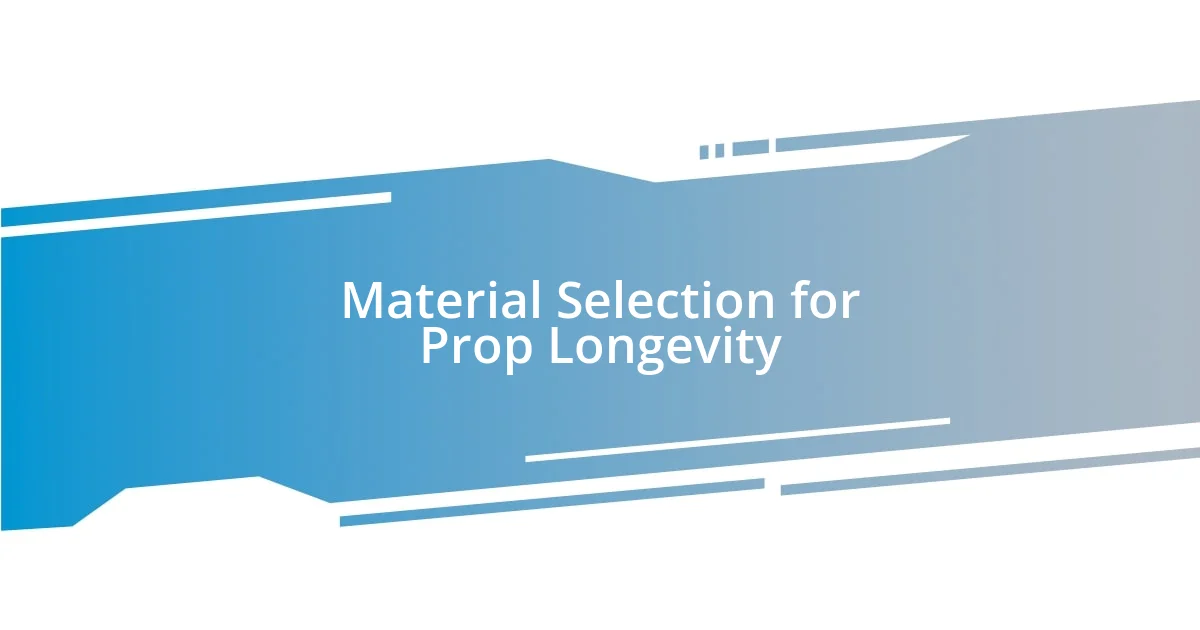Key takeaways:
- Props should be carefully designed to enhance storytelling, with attention to relevance, functionality, and emotional engagement.
- Material selection is crucial for durability and impact, influencing both the longevity of props and their connection to the narrative.
- Collaboration with the design team through effective communication and openness to feedback can elevate the creative process and improve the overall production.

Understanding Prop Design Basics
Prop design is a fascinating blend of creativity and functionality. I remember the thrill I felt during my first project, where I crafted a vintage suitcase. It wasn’t just about making it look good; I had to consider how it would interact with the characters and the story. Have you ever thought about how props can tell a story in their own right?
Diving deeper, understanding materials is essential. I often experiment with different textures and finishes, just like when I chose weathered wood for a tavern table to evoke a sense of history. Each choice impacts how the audience perceives a scene. Isn’t it interesting how the grain of a surface or the shine of a metal can influence mood?
Lastly, the concept of scale cannot be overlooked. I remember designing a giant key for a fantasy play; it had to feel imposing yet believable. This balance makes all the difference in creating an immersive environment. How do you approach scale in your designs? It’s a game-changer, and I believe every designer should embrace it fully.

Key Principles of Effective Props
Props serve as the unsung heroes of storytelling, often carrying weight beyond their physical presence. I recall a time when I designed a broken clock for a dramatic scene; its shattered face symbolized lost time and regret. It wasn’t just a piece to fill space; it struck a chord with the audience, tapping into their emotions and enhancing the narrative. I truly believe every prop should have a purpose that resonates with the story.
When it comes to effective props, there are a few principles I always keep in mind:
- Relevance: Ensure that every prop aligns with the character’s journey and plot development.
- Functionality: Props should not only look good but also serve practical purposes within the scene.
- Visual Impact: Consider how colors, shapes, and textures will attract attention and convey meaning.
- Safety and Durability: Props need to withstand the rigors of performance while being safe for performers and the set.
- Emotionally Engaging: Strive for props that evoke feelings—think of how a weathered book might spark nostalgia.
By focusing on these principles, I find that my props can resonate with both the actors and the audience, enhancing the overall experience.

Crafting Props for Storytelling
Crafting props for storytelling requires a keen eye for detail and an understanding of narrative depth. I distinctly remember creating a worn-out journal for a character burdened with secrets. Each stain and tear became a visual testament to their struggles, allowing the audience to connect emotionally. Have you ever experienced a moment where a simple object seemed to carry the weight of untold stories? It’s in those small details that we breathe life into our narrative.
The materials we use can significantly shape the story we’re telling. I once crafted a delicate glass figurine for a scene depicting fragility in a relationship. That translucent elegance drew viewers in, allowing them to feel the character’s vulnerability. The right material not only matches the aesthetic but also adds layers of meaning to a scene. How often do you consider the impact of the material on the audience’s perception? It can transform a good prop into a great one.
Scale plays a vital role in prop design as well, influencing the emotional response of the audience. I’ve had the opportunity to work on a massive, oversized book for a whimsical production. It immediately set a fantastical tone and made the world feel larger than life. Achieving the right scale can either enhance or detract from the storytelling, and that’s a lesson I’ve learned through trial and error. I often wonder how many designers overlook this pivotal aspect—what do you think?
| Aspect | Significance |
|---|---|
| Materials | Influence emotional depth and audience connection. |
| Details | Small nuances enhance storytelling and character development. |
| Scale | Affects audience perception and emotional response. |

Material Selection for Prop Longevity
Selecting the right materials for props is essential to their longevity. I once used high-density foam for a sword intended for a long-running stage production. Though it looked impressive, I quickly learned that foam doesn’t hold up to extensive use and can easily get damaged. After that experience, I turned to durable thermoplastics, which not only held their shape but also survived the wear and tear of multiple performances. Have you ever underestimated the impact of material on a prop’s lifespan? It was a lesson I won’t forget.
Metal and wood are often my go-to choices for their resilience. I crafted a wooden table for a rustic scene, and its solid structure made it an enduring piece, surviving the high-energy antics of the actors. I remember one performance where an actor accidentally knocked it over—but instead of breaking, it just shifted remarkably. That moment reinforced my belief in choosing sturdy materials; they not only enhance performance safety but also bring a reliable presence to the stage. When you think about your own prop selections, do you consider how much character they can withstand?
Moreover, I always evaluate the environmental conditions props will face when selecting materials. For an outdoor production, I once used waterproof fabric for a backdrop, ensuring it could resist wind and rain. This choice not only preserved the prop but also allowed for impromptu interactions with nature, enhancing the show. It’s fascinating how something as simple as fabric can significantly influence both the practicality and artistry of props. What materials have you found to work successfully under unpredictable circumstances?

Techniques for Realistic Finishes
Creating realistic finishes on props is where artistry truly shines. I remember working on a vintage-looking suitcase for a theatrical production; applying layers of weathering with paint and sandpaper transformed it into a believable artifact. It became an object with history, sparking conversations among audiences about the journeys it had been on. Isn’t it incredible how a few simple techniques can add depth to an everyday item?
I often experiment with different techniques, such as dry brushing and washing, to mimic natural wear and tear. I recall a time when I aged a metal piece by mixing vinegar and salt to create rust, which instantly added authenticity. It’s a tactile process; each brushstroke tells a story of age and significance. Have you considered how these techniques can elevate your own props, making them visually arresting?
Texture plays a pivotal role as well, and I’ve learned the value of contrast in finishes. While working on a prop for a high-tech scene, I combined sleek, shiny elements with rougher, more organic materials. The juxtaposition not only captured attention but also symbolized the conflict in the narrative. How often do you think about the emotional statements your finishes make? I believe that every finish can evoke feelings and thoughts, subtly guiding the audience’s reactions.

Tips for Efficient Prop Scaling
Scaling props efficiently requires a strategic approach to ensure that everything works harmoniously within the set. I learned this the hard way when I created oversized props for a production without considering the stage dimensions. The pieces were stunning, but once on stage, they overwhelmed the space, creating a disjointed visual. Now, I always start with a scale model to visualize proportions before committing to materials. How often do you step back and assess your prop’s relationship with the environment?
Additionally, I find that standardizing measurements can save a lot of time and reduce stress. For example, I developed a set of interchangeable elements for various scenes, allowing me to swiftly adapt to set changes without compromising quality. This flexibility not only streamlines the design process but also fosters creativity. Have you ever thought about how a modular approach could enhance your own efficiency in prop design?
I also recommend sketching out scaling scenarios. While working on a series of architectural props, I drafted several variations to see how each would fit into the overall narrative. After visualizing those ideas, I realized that modifying scale slightly could drastically change the scene’s impact. It was an enlightening moment that reinforced the power of planning. How do you typically approach scaling in your projects? I believe that taking the time to visualize can lead to more cohesive and captivating productions.

Collaborating with the Design Team
Collaborating with the design team is a critical element in the prop design process. I remember a time during a collaborative project where I sat down with the set designers to discuss their vision. It was fascinating to see how our ideas blended together; the discussions sparked creativity I hadn’t anticipated. Have you ever experienced that moment when a collaborative effort elevates your work beyond your original intentions?
Establishing clear communication with fellow designers is vital. When I worked on a large production last year, regular check-ins with the team helped us avoid misunderstandings and misalignments. We created a digital mood board that kept everyone on the same page, which became crucial as the project evolved. I realized that visual tools significantly enhance collaboration. How do you keep everyone aligned in your projects?
Finally, I find that being open to feedback from the design team can lead to unexpected breakthroughs. On one occasion, after receiving suggestions from the lighting designer, I altered a prop’s color scheme that not only complemented the set but also transformed its emotional impact on stage. The collaboration turned out to be a turning point in our creative process. Have you considered how embracing feedback might reshape your own design approach? I’m always amazed at how collaborative efforts can breathe new life into a project.
















